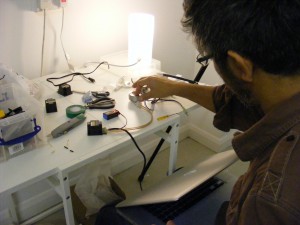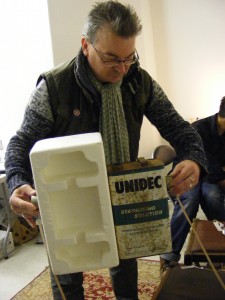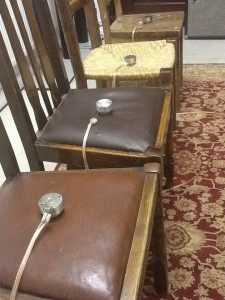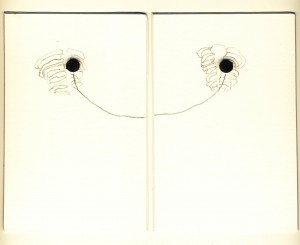Process in Focus
Work in Progress at Soundfjord
On the 2nd-4th of December 2011 Wajid Yaseen and I held a Work in Progress session at the Soundfjord Gallery in London, http://www.soundfjord.org/galleryexhibitions.htm , where the public were invited to take part in the process of thinking through ideas for the sound work we were proposing to develop. Helen Frosi, the curator of the gallery, was enthusiastic about the idea and keen to bring in the public and demystify the process in making sound art work. Wajid and I wanted to bring our combined different experience to the process, and have a dedicated 3 days to have the freedom to explore ideas.
We were both interested in the idea of sound travelling through different materials. During the event we played different sounds, with a recorded sound source, into different materials where every object, structure or body could be a potential amplifier.
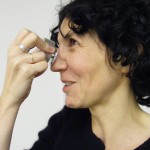
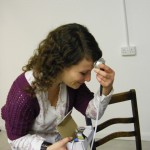
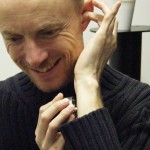
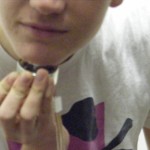
Here are people listening to recorded vocal sounds played into their bodies using tissue and bone as the resonating and amplifying material.
Visitors to the event came through out the weekend, up to 30 including a group of 10 from Enfield Mencap Centre, a few who stayed for a whole day, some who returned on the following day, and those with ages ranging from 1 and a half years old to 70 years old.
[audio:https://shirleypegna.com/wp-content/uploads/2012/02/string-quartet6.mp3|titles=string quartet]
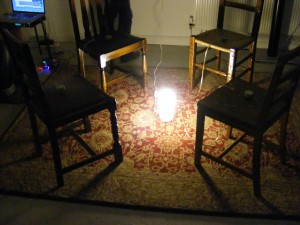
Wajid brought a recording of his composition for a string quartet and we played the sound into the wood of the chairs, using the resonating qualities of the wood to amplify the sound rather than ordinary speakers.
Here is a transducer battery powered kit in the making. It consists of an amp,(40W Kemo –MO34N) a transducer (Low frequency surface transducer – CEPT170A087-125-20MR), a 9v battery and an MP3 player.
[audio:https://shirleypegna.com/wp-content/uploads/2012/02/low-hz-polystyrene4.mp3|titles=resonance of polystyrene]Playing a sine tone through a rusty tin (Sylvia Halletts’ favourite) and polystyrene –(Max Eastleys’ favourite)
[audio:https://shirleypegna.com/wp-content/uploads/2012/02/drop-polyst2.mp3|titles= sound dropping polystyrene]

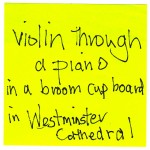
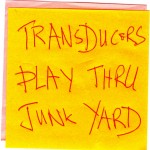

Notes from our Ideas Wall
We questioned the compositional and interactive elements of the ideas. I deliberately wanted the element of composition to come into the discussions, as aspects of my practise have led me away from composing music and sound. I had brought hand held equipment designed to allow the individual to investigate what amplified the sound from the transducer. I was keen to discuss the reasoning that one could have for the choice or choices of recordings.
Do you associate this image with a doctors’ waiting room, or perhaps the prim line up of adjudicating judges seats?
What were the associations with the different settings of the chairs? Memory and association were part of our conversations, as was imagination. The two original ideas we brought along (sound through chairs and sound through the body) we found were linked in a lot of ways, but the contrast between them brought up different and useful viewpoints to wrangle with. There was an element of anthropomorphising the chairs, where the absent musical players were associated with and sometimes seem even to be represented by the chairs.
Disembodiment seemed to be an element present in both of the original ideas.
Listening to an external heart sound through the body


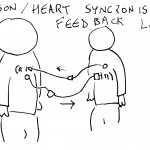

The playing of body sounds into a body was reported as a strange and for some a repelling experience. The radiating internally of an internal sound that did not belong to the listener and was alien, gave rise to loud exclamations. The focus on bodily sounds connected with the notion of the transducers being like stethoscopes or medical objects, almost seemed to suggest the chair was human or the chair had some link with the person that had sat on it.
The speaking voice listed speeds of sound through different materials. We played this sound though different materials.
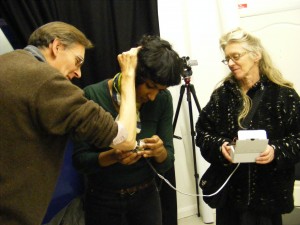
Here people are using the efficient ‘conducting elbow’. The battery-powered kit meant that people could try playing sound through different objects and themselves round and outside the space.
[audio:https://shirleypegna.com/wp-content/uploads/2012/02/testing-voices-yes-.mp3|titles=testing voices ]

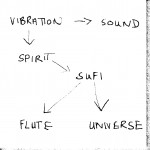



People made images, models and wrote thoughts on our wall of ideas.
The process brought up a number of things:
• The randomly timed entrance of visitors certainly added to the richness of the conversations and variety of different ideas. Experiments were acted upon in the moment, and ideas were kicked off though the fluid movement of people with their imaginations sparking off others and the physical energy of interactivity.
• The re cycling of ideas came about naturally when new people came in and by telling them what we were doing or had been thinking about, our rephrasing for different people instigated new thoughts and ideas. We were taking a step back to recap, but often it took the ideas forward in another direction.
• After the event we reflected the difference between the intuitive ideas and thrashed out ideas – and talked about what could be gained or even lost, by going into detail.
We saw that our two original ideas that were contrasting (sound through chairs and sound through the body) although seemingly opposing ideas cross-fertilised and created new questions, and amongst them the nature of the forms composition and installation and we wondered what would a hybrid piece be like : perhaps a quartet comprised of sounds from ‘four bodies’ perhaps.
Come and see what the next step is at Audiograft 2012. 29th feb – 4th March http://www.audiograft.com
And further developments at BEAM Workshop Day 10th March 2012
http://www.beamestival.com/beam-festival-2012/
[audio:https://shirleypegna.com/wp-content/uploads/2012/02/Ababy-yes.mp3|titles=resonance of baby ]
No babies or toddlers were used to test sound frequency in our event but everything has its own resonant frequency.

Sound – artists’ impression – (aged 11 months) – or was it a scribble?
